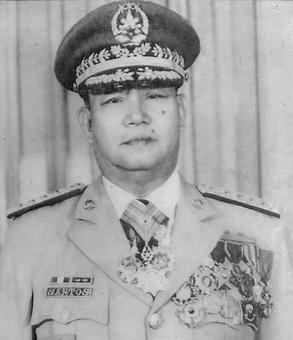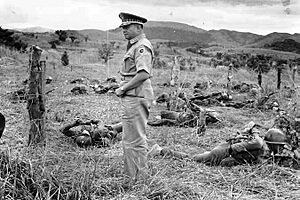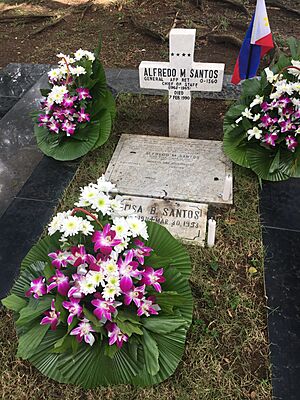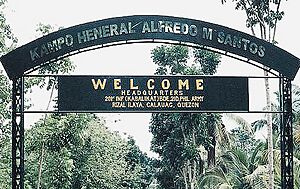Alfredo Santos facts for kids
Quick facts for kids Alfredo Santos |
|
|---|---|

GEN Alfredo M. Santos AFP
|
|
| Chief of Staff of the Armed Forces of the Philippines | |
| In office September 1, 1962 – July 12, 1965 |
|
| President | Diosdado Macapagal |
| Preceded by | Pelagio A. Cruz |
| Succeeded by | Rigoberto Atienza |
| Personal details | |
| Born | Alfredo Manapat Santos July 13, 1905 Santa Cruz, Manila, Philippine Islands |
| Died | February 7, 1990 (aged 84) Manila, Philippines |
| Military service | |
| Nickname(s) | Hammer, Hero of the Pockets, First Four-star General |
| Allegiance | |
| Service/branch | Philippine Army |
| Rank | |
| Commands | Armed Forces of the Philippines |
| Battles/wars | World War II *Battle of Bataan *Philippines campaign (1944-45) *Battle of Luzon *Battle of Manila (1945) |
Alfredo Manapat Santos (born July 13, 1905 – died February 7, 1990) was a very important military leader in the Philippines. He served as the Chief of Staff of the Armed Forces of the Philippines from 1962 to 1965. He made history by becoming the first ever four-star general in the country's armed forces.
Contents
Early Life and Education
Alfredo Santos was born in Santa Cruz, Manila, Philippines, on July 13, 1905. He was one of fourteen children. He went to Manila North High School (now Arellano) for his secondary education. In 1931, he earned a degree in civil engineering from Mapúa Institute of Technology. He also passed his board examination that same year.
Even before his engineering career, he showed a strong interest in the military. He was the top graduate of his ROTC class at the University of the Philippines in 1929. He was a cadet colonel and corps commander. This early interest shaped his future.
Military Career Highlights
Starting His Military Journey
General Santos officially began his military career on June 8, 1936. This was after working as a civil engineer for five years. He joined the Reserve Officer Service School (ROSS) in Baguio City. There, he was chosen as the battalion commander. He graduated at the top of his class. Twenty years later, he was honored as the "Most Distinguished Alumnus" of the school.
The Hero of the Pockets
During the famous Battle of Bataan in World War II, Captain Santos was a highly praised unit commander. His commanding general, Brigadier General Fidel V. Segundo, even called him the "Hammer of the Division." This was because Santos cleverly outsmarted the enemy. The enemy tried to trap his unit in two areas, called "pockets."
But Captain Santos's unit successfully broke through these areas. They were known as the Gogo-Cotar and Tuol Pockets. Because of these brave actions, he earned the nickname "Hero of the Pockets."
For his bravery, he was promoted to major on the battlefield. Just two days later, he received two major awards from the United States Army. These were the Distinguished Service Cross for "extraordinary heroism" and the Silver Star for "gallantry in action." The Philippine Government also gave him similar awards: the Distinguished Conduct Star and the Gold Cross.
Fighting in World War II
In January 1942, a large Japanese Army force attacked in Bataan. They broke through the main defense line of the 1st Regular Division. This created a dangerous gap. Major Santos was given the tough job of closing this gap. He had to defeat the enemy troops who had gotten through the lines.
He led a counter-attack against the strong Japanese forces. The fighting was intense and lasted for days. On April 12, 1942, Major Santos was ordered to surrender his unit to the Japanese. He became a prisoner of war. He was one of the soldiers who had to endure the difficult "Death March" to Camp O'Donnell in Tarlac. He was released from the camp in August 1942.
During the Japanese occupation, he joined a group called the Filipino-American Irregular Troops. He worked as the chief of their Intelligence Division in Manila. He helped fight alongside American and Filipino soldiers to free Manila in 1945. After the war, he continued to serve in various important military roles.
After the War: A Dedicated Leader
In 1946, he went to the United States to study at the Command and General Staff College in Kansas. He completed his course there in 1947.
In 1951, he was offered the chance to become the governor of Cotabato province. This was a political position, not a military one. At that time, Cotabato was facing a lot of unrest. But General Santos decided to decline the offer. He believed his path was in the military. He wanted to reach the highest position in the armed forces. His dedication to his military career was clear.
Battling the Huk Movement
Colonel Santos was later put in charge of the Panay Task Force. This group was fighting against the Huk rebels. He showed his amazing military skills once again. He was known for capturing two of the highest-ranking Huk leaders.
He made a very smart decision during this campaign. He organized a civilian commando unit led by Pedro Valentin. This mountain leader knew the local people and the area very well. Colonel Santos made this civilian unit the main attacking force. This helped them capture Guillermo Capadocia, a founder of the Communist Party of the Philippines (CPP).
His constant military operations led to many rebels surrendering. They also captured important weapons and documents. This greatly weakened the Huk movement in the Visayas and Mindanao regions.
A Bold Plan and Victory
Colonel Santos also played a key role in capturing another Huk leader, Mariano P. Balgos, in the Bicol region. He made a risky decision to pull out most of his army troops from nearby provinces. He focused all operations on the Manito area, where Balgos was hiding.
A strong typhoon helped his plan. Balgos was known to love sardines. So, a sardine company helped by putting a special substance in the sardines sold near Balgos's hideout. A scout ranger team found Balgos and caught him. His death was a huge victory. It stopped the Huk movement from growing in the Bicol region.
Because of his success in these campaigns, Colonel Santos was promoted to brigadier general in 1955. His efforts against the Huk movement inspired military leaders in other Southeast Asian countries. He received several honors, including the Philippine Legion of Honor and another Legion of Honor from the United States.
Leading the Philippine Army
In 1960, General Santos became the commanding general of the Philippine Army. He focused on improving the careers of officers. He made sure they received proper training and schooling. He also cared deeply about his soldiers' well-being. He worked to improve their living conditions and morale. He even started projects to help soldiers prepare for civilian life after their service.
He believed in promoting officers based on their skills and hard work. His fair decisions helped the army work together effectively. On September 1, 1962, President Diosdado Macapagal appointed him as the Chief of Staff of the AFP. This made him the first ROTC graduate to reach the highest military position. He also became the first one-star general to be promoted directly to a three-star rank, that of lieutenant general.
Joining the Hall of Fame
General Santos received a great honor in 1973. He was chosen for the Allied Officers Hall of Fame at the United States Army Command and General Staff in Kansas. This recognized his outstanding military achievements as Chief of Staff of the AFP.
Awards and Decorations
National Honours
 Legion of Honor
Legion of Honor Distinguished Conduct Star
Distinguished Conduct Star Distinguished Service Star (7)
Distinguished Service Star (7) Gold Cross Medal
Gold Cross Medal Long Service Medal (2)
Long Service Medal (2) Philippine Defense Medal
Philippine Defense Medal Anti-Dissidence Campaign Medal
Anti-Dissidence Campaign Medal Philippine Independence Medal
Philippine Independence Medal Philippine Liberation Medal
Philippine Liberation Medal
Foreign Honours
 USA :
USA :
 Army Distinguished Service Cross
Army Distinguished Service Cross Silver Star Medal
Silver Star Medal Officer of the Legion of Merit
Officer of the Legion of Merit Asia-Pacific Theater Campaign Medal
Asia-Pacific Theater Campaign Medal American Defense Medal
American Defense Medal World War II Victory Medal
World War II Victory Medal
 South Vietnam :
South Vietnam :
 Thailand :
Thailand :
 South Korea :
South Korea :
 Taiwan :
Taiwan :
Badge
Milestones and Achievements
- He was the Corps Commander of the Manila North High School Cadet Corps from 1924-1925.
- He was the Corps Commander of the University of the Philippines R.O.T.C. from 1928-1929, and an Honor Graduate.
- He was the Honor Graduate and Topnotcher of the First Reserve Officers Service School in 1936. He was named its Most Outstanding Graduate in 1956.
- He was the first Chief of the SEATO Military Planning Office in Bangkok, Thailand, from 1957-1958.
- He was the first ROTC graduate to become commanding general of the Philippine Army (1960-1962).
- He was the first ROTC graduate to become Chief of Staff of the Armed Forces of the Philippines (1962–1965).
- He became the first Filipino four-star general in 1963.
- He was the first Filipino General to receive a Doctor of Laws degree (Honoris Causa) in 1965.
- He was the first Filipino General to speak at the Imperial Defense College (a top British military institution) in London, England, in 1965.
- During the Bataan Campaign, he was called the "Hammer of the 1st Regular Division" for outsmarting the Japanese.
- Also during the Bataan campaign, his unit broke through two "pockets" (Gogo-Cotar and Tulo Pockets) created by the Japanese, earning him the title "Hero of the Pockets."
- He was part of the infamous "Death March" and was held in the Capas, Tarlac Prisoners of War Concentration Camp.
- General Santos was known for capturing or causing the death of key Communist Party leaders: Guillermo Capadocia (1951), Mariano P. Balgos (1954), and Dr. Jesus M. Lava (1964).
- He was selected as one of the 22 Outstanding Soldiers in Philippine History by the Military Historical Division, AFP, in December 1951.
- He was inducted into the Allied Officer Hall of Fame at the US Army Command and General Staff College, Fort Leavenworth, for his outstanding military achievements.
See Also
- University of the Philippines ROTC Unit
- Armed Forces of the Philippines
- Libingan ng mga Bayani
- Battle of Manila (1945)
- Battle of Luzon
- Labanan sa Maynila (1945)
- Labanan sa Luzon





